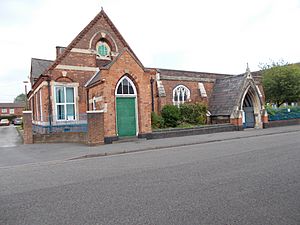St Clement's Church, Nechells facts for kids
Quick facts for kids St Clement’s Church, Nechells |
|
|---|---|
| 52°29′58″N 1°52′1.5″W / 52.49944°N 1.867083°W | |
| Location | Nechells |
| Country | England |
| Denomination | Church of England |
| History | |
| Dedication | St Clement |
| Consecrated | 1859 |
| Architecture | |
| Architect(s) | J.A. Chatwin |
| Groundbreaking | 1859 |
| Completed | 1860 |
| Demolished | 1978 |
St Clement's Church in Nechells, Birmingham, was once a special church for the local community. It belonged to the Church of England. The church was dedicated to Saint Clement.
Contents
History of St Clement's Church
Building the Church
A famous architect named J.A. Chatwin designed St Clement's Church. It was the very first church he designed! The church was officially opened and blessed by the Bishop of Worcester on August 30, 1859.
A local newspaper, Aris's Birmingham Gazette, described the church as a "handsome" (meaning beautiful) building. It was built in the Gothic style, which is known for its pointed arches and tall windows. The church could hold 852 people.
The building cost £3,500, which included the architect's fee. This was considered a good price for such a large and well-designed church at the time. Some parts of its design, like the round "rose window" and its tall, pointed tower, were in a style called "Decorated."
Later, in the 1960s, an expert named Nicholas Pevsner said that while Chatwin's design was very detailed, it wasn't very exciting. You can still see two of Chatwin's original drawings for the church online. These drawings show the church's floor plan and its gallery.
Becoming a Parish
St Clement's Church became a parish church in 1860. This meant it had its own area and community to serve. Before this, it was part of the larger St Matthew's Church, Duddeston and Nechells parish.
In 1879, a part of St Clement's parish was used to create a new parish for St Catherine's Church, Nechells.
The Church's End
Sadly, St Clement's Church was no longer needed by 1975. It was then taken down, or demolished, by 1978.
However, a hall that was built next to the church in 1887 still stands today. This hall was designed by an architect named William Jenkins. It is now used by the Birmingham Victory Unity Centre.
The Church Organ
About the Organ
St Clement's Church had a large musical instrument called a pipe organ. This organ was originally from St James’ Church in Liverpool. You can find details about this organ on a special list called the National Pipe Organ Register.
Organ's History
In 1907, the organ was rebuilt by a company called Halmshaw and King. After the church was demolished in the 1970s, no one knows what happened to the organ. Its fate remains a mystery.


